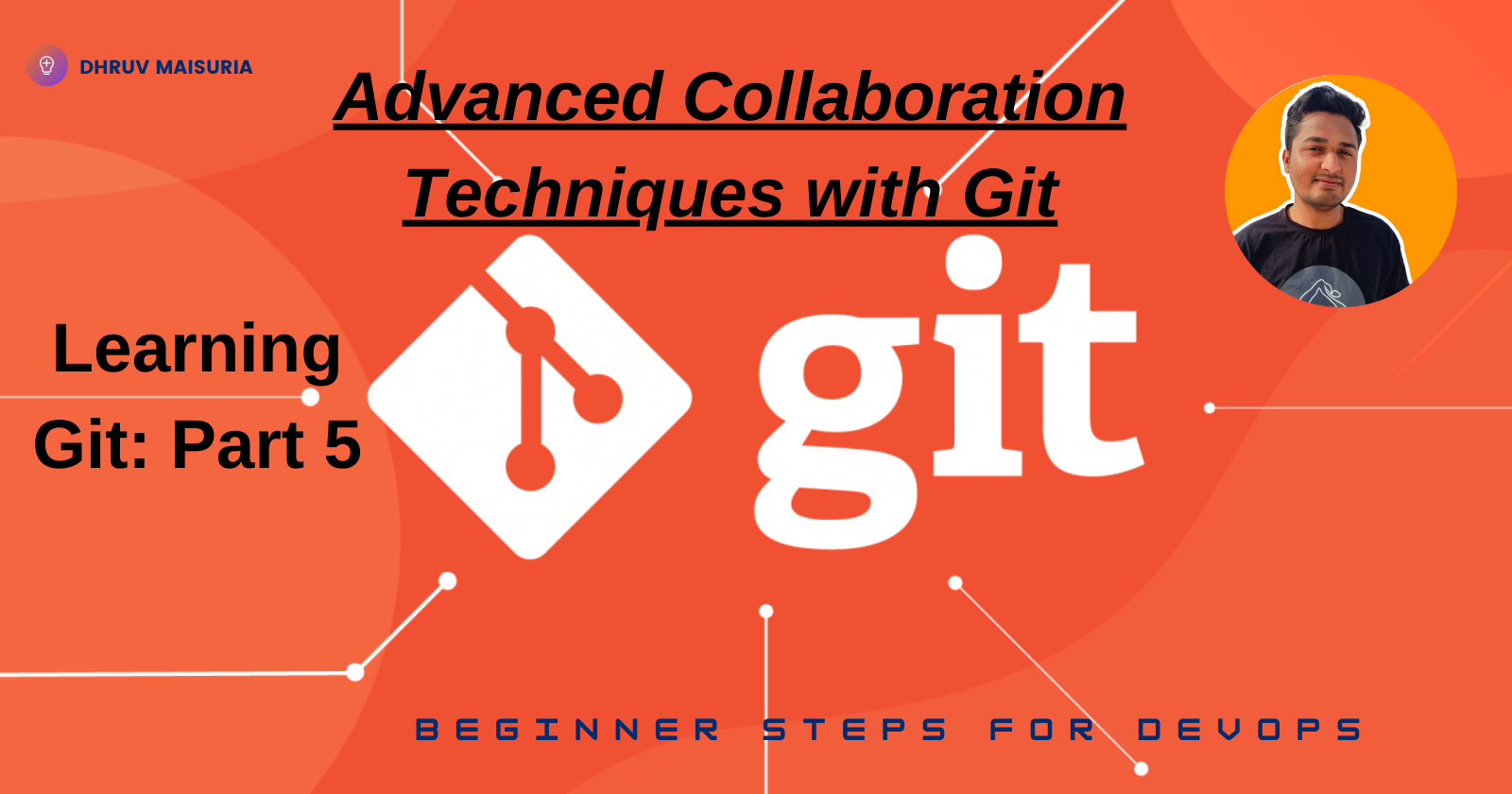Learning Git: Part 5
 Dhruvkumar Maisuria
Dhruvkumar Maisuria
Introduction
Welcome to the final part of our Git series in the DevOps learning journey! So far, we've covered Git basics, branching and merging, advanced Git concepts, and strategies and best practices. In this final installment, we'll dive into advanced collaboration techniques with Git, integrating Git with other tools, and automating workflows to enhance team productivity and streamline your development process.
Advanced Collaboration Techniques
Effective collaboration is key to successful project development. Here are some advanced techniques to improve collaboration using Git.
1. Pull Requests (PRs)
Pull requests are a powerful feature for code review and collaboration, allowing team members to discuss changes before they are merged into the main codebase.
Creating a Pull Request:
Push your branch to the remote repository.
git push origin feature-branchOn the repository's GitHub page, click "New pull request".
Select the feature branch to merge into the main branch.
Add a descriptive title and comment, then submit the pull request.
Reviewing and Merging a Pull Request:
Review the code changes in the pull request.
Add comments or request changes if necessary.
Approve the pull request.
Merge the pull request into the main branch using the "Merge" button.
2. Code Reviews
Code reviews are essential for maintaining code quality and sharing knowledge among team members.
Best Practices for Code Reviews:
Review code in small, manageable chunks.
Provide constructive feedback and suggest improvements.
Ensure code adheres to coding standards and best practices.
Test the code to verify its functionality.
3. Pair Programming
Pair programming involves two developers working together at one workstation. One writes code (driver), and the other reviews each line of code as it’s written (observer).
Benefits of Pair Programming:
Improves code quality and reduces bugs.
Facilitates knowledge sharing and mentorship.
Enhances collaboration and teamwork.
Integrating Git with Other Tools
To maximize efficiency, integrate Git with other tools in your development workflow.
1. Continuous Integration/Continuous Deployment (CI/CD)
CI/CD automates the testing, building, and deployment of your code. Popular CI/CD tools include Jenkins, GitLab CI/CD, CircleCI, and GitHub Actions.
Setting Up GitHub Actions for CI/CD:
Create a
.github/workflowsdirectory in your repository.Create a YAML file for your workflow (e.g.,
ci.yml).name: CI on: [push, pull_request] jobs: build: runs-on: ubuntu-latest steps: - uses: actions/checkout@v2 - name: Set up Node.js uses: actions/setup-node@v2 with: node-version: '14' - run: npm install - run: npm testCommit and push the workflow file to trigger the CI process.
2. Issue Tracking and Project Management
Integrate Git with issue tracking and project management tools like Jira, Trello, or GitHub Projects to streamline task management and collaboration.
Creating Issues and Linking to Pull Requests:
Create an issue to describe a task or bug.
Reference the issue in your branch name and commit messages (e.g.,
feature/#123-new-feature).Link the pull request to the issue by mentioning the issue number (e.g.,
Closes #123).
3. Documentation
Maintaining up-to-date documentation is crucial for project success. Tools like MkDocs, Sphinx, and GitHub Pages help create and publish project documentation.
Generating Documentation with MkDocs:
Install MkDocs:
pip install mkdocsCreate a new MkDocs project:
mkdocs new my-project cd my-projectBuild and serve the documentation locally:
mkdocs serveDeploy the documentation:
mkdocs gh-deploy
Automating Workflows
Automation reduces manual effort and enhances productivity. Here are some ways to automate workflows with Git.
1. Git Hooks
Git hooks are scripts that run automatically at specific points in the Git lifecycle, such as before or after commits, pushes, and merges.
Setting Up a Pre-Commit Hook:
Create a
pre-commitfile in the.git/hooksdirectory.touch .git/hooks/pre-commitAdd executable permissions to the hook file:
chmod +x .git/hooks/pre-commitAdd your script to the hook file:
#!/bin/bash npm run lint
2. Automated Code Formatting
Tools like Prettier and ESLint can automatically format and lint your code to ensure consistency and code quality.
Setting Up Prettier:
Install Prettier:
npm install --save-dev prettierCreate a
.prettierrcconfiguration file:{ "singleQuote": true, "trailingComma": "all" }Add a format script to
package.json:"scripts": { "format": "prettier --write ." }
3. Automated Testing
Automated tests ensure that your code works as expected and prevent regressions. Popular testing frameworks include Jest, Mocha, and PyTest.
Setting Up Jest for JavaScript Testing:
Install Jest:
npm install --save-dev jestCreate a
testscript inpackage.json:"scripts": { "test": "jest" }Write and run tests:
npm test
Conclusion
In this final part, we've explored advanced collaboration techniques with Git, integrating Git with other tools, and automating workflows to enhance productivity and streamline development processes. By applying these techniques, you can improve team collaboration, maintain high code quality, and automate repetitive tasks, allowing you to focus on building great software.
Thank you for following along with this Git series in our DevOps learning journey. We hope you found it informative and valuable. Stay tuned for more articles and tutorials on DevOps topics.
Estimated Time to Complete: 3-4 hours
This blog is part of our DevOps learning series. For more articles, visit my Devops with dhruv09 Page.
If you have any questions or need further clarification on any of the steps, please feel free to reach out. Happy coding!
This concludes our Git series. Stay tuned for more DevOps articles!
Remember to follow our series to keep up with the latest updates and learning materials in DevOps!
Stay connected and keep learning!
Author: [ DHRUVKUMAR MAISURIA ]
GitHub: GitHub Profile
Hashnode: Hashnode Profile
LinkedIn: LinkedIn Profile
Subscribe to my newsletter
Read articles from Dhruvkumar Maisuria directly inside your inbox. Subscribe to the newsletter, and don't miss out.
Written by

Dhruvkumar Maisuria
Dhruvkumar Maisuria
About Me As a dedicated tech enthusiast with a passion for continuous learning, I possess a robust background in software development and network engineering. My journey in the tech world is marked by an insatiable curiosity and a drive to solve complex problems through innovative solutions. I have honed my skills across a diverse array of technologies, including Python, AWS, SQL, and Golang, and have a strong foundation in web development, API testing, and cloud computing. My hands-on experience ranges from creating sophisticated applications to optimizing network performance, underscored by a commitment to excellence and a meticulous attention to detail. In addition to my technical prowess, I am an avid advocate for knowledge sharing, regularly contributing to the tech community through blogs and open-source projects. My proactive approach to professional development is demonstrated by my ongoing exploration of advanced concepts in programming and networking, ensuring that I stay at the forefront of industry trends. My professional journey is a testament to my adaptability and eagerness to embrace new challenges, making me a valuable asset in any dynamic, forward-thinking team. Whether working on a collaborative project or independently, I bring a blend of analytical thinking, creative problem-solving, and a deep-seated passion for technology to every endeavor.